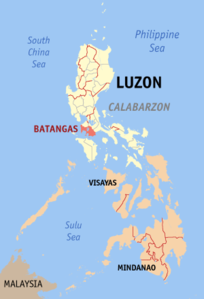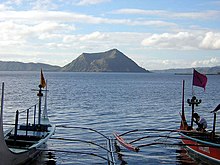Batangas Province
| Basic data | |
|---|---|
| Region : | CALABARZON |
| Capital : | Batangas City |
| Population : | 2,694,335 August 1, 2015 census
|
| Population density : | 864 inhabitants per km² |
| Area : | 3,119.75 km² |
| PSGC : | 041000000 |
| Governor : | Vilma Santos Recto |
| Official website: | http://www.batangas.gov.ph/ |
| structure | |
| - Highly urbanized cities | |
| - provincial cities | 3 |
| - municipalities | 31 |
| - Barangays | 1,078 |
| - electoral districts | 4th |
| Location of the province in the Philippines | |

|
|
Coordinates: 13 ° 50 ′ N , 121 ° 0 ′ E Batangas is a province of the Philippines . It is located southwest of the capital Manila on the island of Luzon and is part of the administrative region IV-A, CALABARZON .
geography
The province is located in the southwest of the island of Luzon, opposite the island of Mindoro . Long sandy beaches stretch along its coastline on the South China Sea in the northwest, on the Calatagan Peninsula and on the Isla Verde Strait in the southwest. To the north and east are the neighboring provinces of Cavite , Quezon and Laguna . The topography is generally described as a flat undulating landscape. The highest mountains are the Makulot (830 m), Talamitan (700 m), Pico de Loro (664 m), Batulao (811 m), the Manabo (830 m) and the Daguldol (672 m). The Taal Lake , north of Batangas City, is the third largest in the Philippines, and the 400 meter high and active Taal Volcano rises in the lake , both of which were declared Taal Volcano National Park in 1996. Another volcano is the 501 meter high Panay , it is located on the Calumpang Peninsula , which separates Batangas Bay from Balayan Bay . There are popular diving spots in both bays. The province's last larger rainforests are located in the 39.95 km² Mounts Palay-Palay-Mataas Na Gulod National Park in the northeast of the province. Well-known islands that belong to the province are Fortune and Verde Island .
history
The first historical records of the region where Batangas is located are known from Chinese sources. Chinese merchants toured the region as early as the first millennium AD and traded with the native Negritos . At the same time, the settlement of Tondo in Manila Bay was established. The region was first referred to as candy by the locals , a derivation of the word "bongbong", a part of the bamboo shrub used to hunt fish.
According to the lore of the indigenous Maragtas, the area of the province was settled by Malays from Borneo and Panay in the 13th century . At least two leaders are known from this period, Datu Balensusa and Datu Dumangsil. During the reign of Datu Kumintang, royal rule was installed, so the first Spanish province was first named Balayan de Kumintang .
In 1570 the region was entered by the two conquistadors Martín de Goiti and Juan de Salcedo on their way to Manila. They explored the area around the Bonbon River, where de Salcedo was almost killed by a poisoned arrow. In 1578, after the subjugation of the local rulers by Br. Esteban Ortis and Br. Juan de Porres, the province of Balayan de Kumintang was founded. It included the present-day provinces of Mindoro, Marinduque , the southeast of the Laguna province and parts of Camarines Norte .
Mindoro and Marinduque were separated from the province in the early 17th century, and the capital was relocated to Taal in 1732. Taal, known as the pride of southern Tagalog , was devastated by the eruption of the Taal volcano in 1754 and the capital was moved to Batangas City. Only since then has the province been called Batangas.
Many of the leaders of the Philippine Revolution (1896–1898) and the Philippine-American War (1899–1902) came from the Batangas Province, so the province symbolizes one of the eight rays in the flag of the Philippines .
Significant buildings
- Basilica of St. Martin of Tours , it is considered the largest church building in Southeast and East Asia .
Administrative division
The province's 31 municipalities ( Municipalities ) and three Component Cities divided. For the elections to the House of Representatives of the Philippines , the province is divided into four electoral districts.
Cities
Boroughs
Colleges
Personalities
- Felipe Agoncillo was a Filipino lawyer and diplomat at the time of the First Republic of the Philippines and a member of the Batangas Province in the Philippine Assembly (1907-1916).
- Corazon Amurao (* 1943) is a former nurse in Washington, DC. She came to Chicago as an exchange student in 1966 and was the only survivor of a mass murder of eight nurses that same year ; her appearance in court in Peoria made Amurao the most famous Filipino woman in the United States.
- Apolinario Mabini was a Filipino politician and theorist and is one of the national heroes of the Philippines .
- José P. Laurel was a Filipino politician and President of the Philippines .

